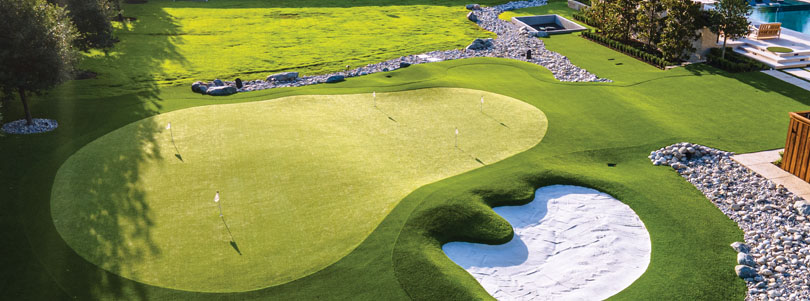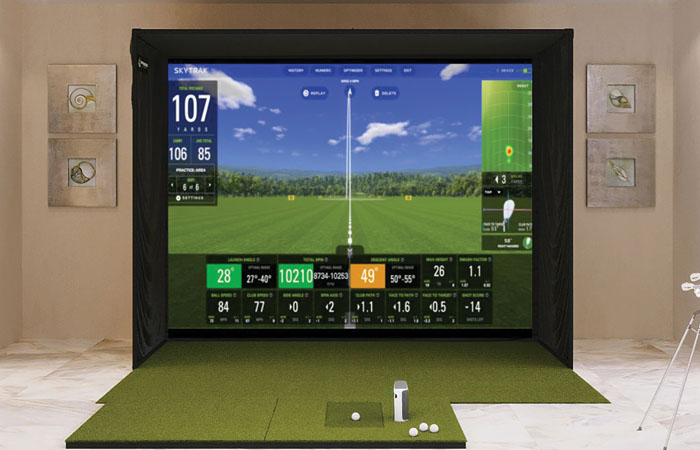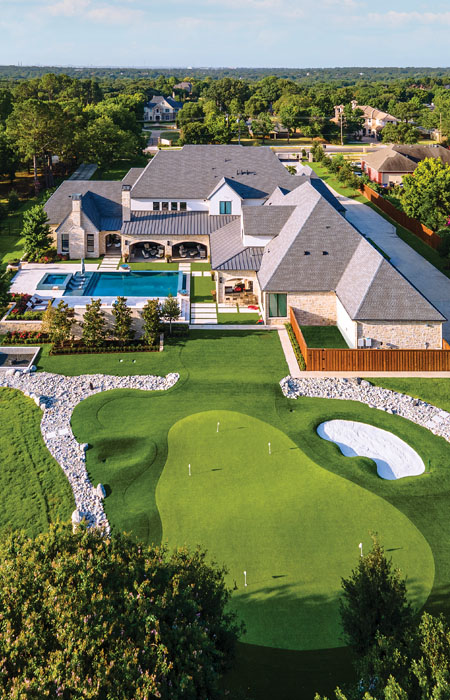Cover Story – Every Golfer’s Dream

Every golfer has long imagined hitting all six of those magical lottery numbers and then joining that expensive country club, buying all the latest equipment, and building an amazing setup in their home to keep their game sharp and entertain their buddies. Over the last several years, companies that specialize in home golf simulators, putting greens, and even backyard holes or short courses, have become more prominent. AVIDGOLFER went to some of these companies and their representatives to find out just how those processes work and how customizable your backyard or indoor golf oasis can be.
INDOOR GOLF SIMULATORS
If you have been following the advancing technology or have tuned into the Golf Channel anytime over the last several years, then you have likely been tracking the uptick in home golf simulators. In addition, many indoor golf simulator shops have opened in DFW over the last several years, and some higher-end country clubs are even integrating indoor simulators for not only lessons and club fittings, but also for member entertainment, when the course is closed for maintenance, or when temperatures are not ideal for outdoor play.
“The technology has become so good that golfers are trusting it more and more. And there are so many price points available, I think they are becoming a more interesting and affordable option for players,” says Jeff Wood, the Vice President of Marketing for The Indoor Golf Shop.

Indoor golf simulators in the home are a newer trend for affluent young professionals that has seen a steady growth over the last few years. The good news is these simulators are far more affordable than they once were. It is completely feasible to build your own DIY simulator setup in a garage or media room with relative ease and cost. Of course, these builds can run the gamut from affordable, into the thousands of dollars with customizable equipment and professional installation. What’s not to like about an indoor simulator? It allows you to practice in the comfort of your own home, while also giving you instant feedback on numbers like clubhead speed, ball speed, spin rates and smash factor. You can also upload courses and play virtual rounds alone or with a group of friends. Simulators are a no-brainer for the golf obsessed, and with so many options, they are more customizable than ever.
What do I need?
The first thing you will need is the necessary space for your netting and equipment. You will also need to come up with a budget for your project. This can be a little tricky, as there are many variables when choosing equipment. The Cliff’s notes suggest you need a launch monitor, netting, screen, artificial turf mat, projector, and the necessary software to run the program. It’s actually not as complex as you might think.
A good baseline launch monitor is the SkyTrak+, which is a dual doppler radar and photometric based system that captures ball data like carry distance, total distance, backspin, side spin, distance off center, launch angle, and more. It also measures club speed, club path, face to path, and face to target.
Is there a package option?
There is a great option for those who are interested in a full simulator package. The Indoor Golf Shop, which is a company based out Celina, offers several of these packages, ranging in price depending on options. Their SkyTrak + SIG10 package comes with everything you will need to get up and running, including a SkyTrak+ Launch Monitor, complete studio setup with netting and turf, a SIGPRO premium screen, projector with cables and software. Although the price point on an option like this one may not be for everyone, you may be pleasantly surprised just how affordable they can be, and financing is available, meaning a setup like this one may be more attainable than you might think.
“We sell a lot of the mid-range in-home packages,” says Wood. “That has become our bread and butter. We sell them all day, every day.”
I want to play multiple famous courses on my simulator. Is that possible?
Absolutely. The launch monitors these days come right out of the box with a number of courses. It might be as few as five or as many as 25. After that, there are subscription services that can open up more courses for you. The simulator links with those services and software providers to allow access to more courses. All told, there are thousands of courses available to play, depending on which subscription you might choose.
OUTDOOR PUTTING GREENS
If you still want the joy of being outdoors while working on your game, then you always have the option to build and customize your own outdoor putting green. This is another trend that has really taken off as the cost of these projects has become more affordable and more practical. Gone are the days of the old AstroTurf Putt-Putt artificial surfaces. Now, the artificial turf reacts just like natural grass, and can be custom made to a specific speed just for golf purposes. These outdoor putting and chipping greens are contoured just like something you might see on a real course, with undulations, multiple holes, proper drainage, lighting, and even upgrades like tee boxes and real sand bunkers.

The good news about these backyard putting greens is you don’t need a lot of property to build one. They can be relatively small, and they can get larger and more intricate depending on your property size and budget. We at AG have seen smaller greens that only have enough room for two holes, which offers the owner some area to work on 20-foot-and-in putts. On the flip-side, we have also seen massive outdoor practice areas, not only in places like The Ronny Golf Park at the PGA Frisco development, but also on private properties. While researching this cover story, we were able to visit a home in DFW that has a huge 8,000 square foot, artificial backdoor green, complete with multiple tee boxes around the property, one extending out to about 60 yards. And this practice green even has a real sand bunker and undulations that can offer a wide variety of uphill and downhill putts that break any number of ways. Not only is this a great place to practice and keep your game sharp, but also to entertain family and friends.
Of course, something like we just described is a lot of work. Not only will you need a lot of area, but also a pretty substantial budget. So that may be a build only suited for a few. But there are tons of options for your backyard green, so don’t feel like it’s not attainable.
The bottom line is these projects can be as small and simple or as grand scale and intricate as you choose. Regardless, both are a great way to not only keep your short game sharp, but also entertain and make your golf buddies jealous.
How are the greens constructed?
We spoke with Jason Schultz and Nic Barton, who are the brains behind Premier Greens of Texas, which is an exclusive partner of Celebrity Greens. They specialize in these backyard projects, and also are responsible for the aforementioned Ronny Golf Park at the Northern Texas PGA in Frisco. Their builds are 100 percent customizable, well planned, and place a priority on attention to detail and playability. In general, artificial turf is available in different specializations, shadings, blade heights, and more. At Premier Greens, they carry a wide variety of synthetic grass types to fit into these categories. One of their many top-quality artificial grass products is their synthetic golf greens.

Premier Greens’ synthetic turf has been specially engineered to capture the ideal surface for golf, specifically putting. Their surfaces are also receptive to wedge shots, reacting similar to natural grass, making them a low-maintenance, durable substitute for going broke trying to build a green of your own in your backyard.
“We want them to react and feel like natural grass, and I think the materials we use and the process makes it feel and play like you are on natural grass,” says Schultz.
For the larger project we took a look at, they actually brought in one of Pete Dye and Jack Nicklaus’ former green shapers to move the dirt to the proper place to build on. Now, that’s attention to detail!
What is the timeline on a backyard green project?
It goes without saying, but this is based on size. Projects require an initial site visit, and then a video rendering will be presented to the homeowner before construction begins. From there, smaller putting greens can be completed in as little as a week. For larger, more customized builds like the one AG visited, they can still be ready for play in 6-8 weeks, which, given the size of some of the builds, is quite extraordinary.
What about maintenance costs?
Maintenance costs are surprisingly low, even for major custom builds. Costs can run as little as about $500 a year, with really only one major upkeep annually. So, if you factor in all the money you will save on fertilizer and irrigation for a natural grass backyard, the maintenance on these backyard greens actually pays for itself.
OUTDOOR GOLF COURSES/HOLES
If you want the ultimate, then you need look no further than building your own natural grass backyard hole or short course. These are few and far between, as the maintenance costs and equipment necessary to maintain something on this scale is not only expensive, but with advances in artificial turf, it’s not as practical as it once was. I’m sure there are several homes with land that have constructed their own hole or two loops on property, but there probably aren’t many in DFW that have had it professionally done. There is one that comes to mind AG had the privilege of seeing as it was built, the Tee Pee Par 3 course. This course is at a private residence on the land behind the house. When I say this project spared no expense, I mean it. This course is nine holes, ranging from about 45 yards to just over 70, but the way the course is routed, you are bound by only your imagination. Meaning you can stand on a tee and pick any green to play to, and those shots can reach as much as 140 yards. This course was designed by John Colligan and Trey Kemp, who are known for many courses in the area, including Mansfield National, Texas Rangers Golf Club and Rockwood in Fort Worth.
This property truly reminds you of a mini–Augusta National. Any golf purist would be drooling, should they see it.

Where do I start?
Obviously budget is the first place to begin. This won’t be cheap, but if you have the bucks, it can be done. From there, you need to start calling architects and see who might be available and willing to tackle your project. There will also be a fee to the architecture firm, so be sure to add that to the potential budget.
What are the first steps?
As with an artificial surface, the first step is a property visit. After that, aerial photos, topography maps, and utility information are collected before an original rendering is completed and presented to the client. For something like the Tee Pee Par 3, the design took about two months.
How long does it take to build?
For a major project, once the final architecture plans are approved, the construction can take a few months. For the Tee Pee, it was about four months total to get the course shaped and grassed. From there, depending on season, grow in will take another two months minimum. So, it is possible the entire process could take, at minimum, a year from first meeting to completion. If you have been following along, this is why many people choose artificial turf over natural grass for projects like this. Not only is it far more affordable, but the turnaround time on your dream backyard is also much quicker.

What about cost?
Needless to say, the cost associated with something like this is very substantial. Natural grass greens require specialized equipment, mowers, rollers, and constant attention. Maintaining something on this scale is borderline impossible without a whole warehouse of equipment, and at minimum, a small maintenance staff. The upkeep is constant, from mowing, to fertilizing, and then you have the irrigation costs associated. Sure, you will have the best of everything, but sleep on it for a few days and things can spiral out of control very quickly, turning your massive investment against you in short order.
At the end of the day, building that indoor man cave simulator or outdoor practice facility can be as simple or as intricate as you choose. But one thing is for sure, once you complete your dream setup, you won’t be able to keep your golf buddies away. You don’t have to buy the best to enjoy it, but you don’t want to skimp and be disappointed either.
Like anything else related to golf, you get out of it what you put into it, so spend the extra coin to make sure you are getting exactly what you want. After all, it’s just money, and we can’t take it with us when we go.



